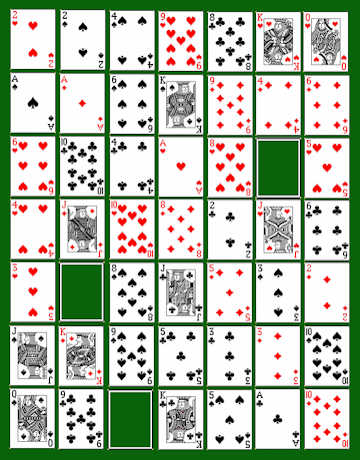Copyright
- Start
- From a 52-card pack remove the Queen of clubs, the Queen of diamonds and one of the Sevens. Deal the remaining 49 cards face up in seven rows of seven. Turn the three Sevens face down and call them Jokers. (Or, if you prefer, use real Jokers face up instead of Sevens face down.) Then exchange the spade Queen for the bottom left corner card, and the heart Queen for the top right corner card, so that the two Queens occupy diagonally opposite corners. One player is Black, and places a black chess king on the heart Queen. The other player is Red and correspondingly places a nominally red (or actually white) chess king on the spade Queen. Each chess king is a Romeo and each card Queen a Juliet.
- Object
- To be the first to move your Romeo to your corresponding Juliet at the diagonally opposite corner.
- Play
- Red moves first and each plays in turn. At each turn you either move your Romeo or swap two cards in the layout, in accordance with the rules below.
- Moving your Romeo
-
The rules of movement are:

Example Given this layout (in which greenbacks are Jokers),
Black Romeo can reach black Juliet in nine moves as follows:










However, unless any cards are swapped, Red Romeo will
have reached his matching Juliet in just five:






- On your opening move you move Romeo like a chess king to any one of the three adjacent cards. Thereafter:
- From a red numeral you move vertically, up or down as preferred, the number of cards indicated by the numeral you are on (counting ace as one and others at face value);
- From a black numeral you move horizontally, left or right as preferred, the number of cards indicated by the card you are on.
- From a King, you move like a chess king, one step to any one of up to eight immediately surrounding cards, except that you may not make a move that would take you over an edge.
- From a Jack, you move like a chess knight to any one of up to eight cards, except that you may not make a move that would take you over an edge.
- From a Joker you move to any card from which you could legally have reached it. (Including the one you last moved from.)
- Swapping two cards
- On your turn to play, you may swap one of the Jokers for any other card in the same row or column. Neither of these cards may be occupied, neither may be one of the cards involved in the most recently performed swap, and neither may be a Queen.
- Winning
- To win, you must reach your Juliet on an exact number of moves. That is, if moving from a numeral card you must take the full value of your move. You may, of course, reach her from a King or a Jack if possible.
- Notes
- Note 1. Counting "over the edge" is easy if you remember that moving seven cards in
a given direction would bring you right back to the one you started from (which is why Sevens are omitted). Therefore,
moving 8, 9 or 10 is the same as moving (respectively) 1, 2 or 3 in the same direction. Similarly, moving 4, 5 or 6 in
one direction is the same as moving (respectively) 3, 2 or 1 in the opposite direction. So, in the
illustration above, moving from
 9 in a downwards direction
brings you to
9 in a downwards direction
brings you to  A, since 9 is the same as 2, while moving upwards
from it brings you to
A, since 9 is the same as 2, while moving upwards
from it brings you to  5 - that is, 2 up from the
bottom edge.
[Return]
5 - that is, 2 up from the
bottom edge.
[Return] - Note 2. But you can, of course, get to a card on the other side of the other Romeo by moving away from it in the opposite direction and continuing from "over the edge". [Return]